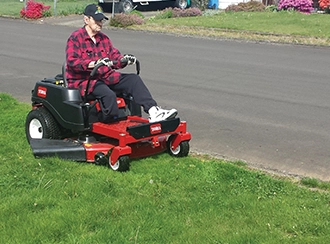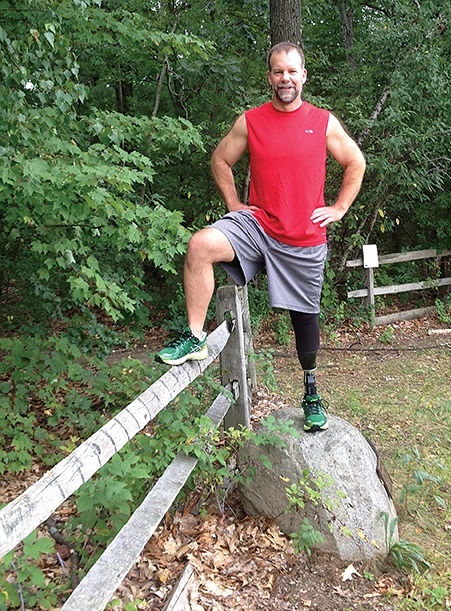By Scott McNutt

A reality of post-amputation life is learning how to manage pain—often, more than one type. New amputees must master pain-management strategies as part of their “new normal.” To move from surviving to thriving, pain control is critical.
Pain is not easy to manage. Identifying the type of pain, its source, and appropriate treatments often requires time, dedication, and trial and error. However, if you are dealing with pain, recognizing the types, knowing about treatment options, and learning how others control pain may help.
Pain Associated With Amputation
Acute pain starts suddenly and is usually related to bodily trauma, such as injury or surgery. It is resolved by appropriately treating the cause.
Back and joint pain may trouble amputees because of alterations in the mechanics of their movements and added reliance on back muscles and remaining joints.
Chronic pain lasts longer than six months and may have underlying causes, such as an unrecognized injury, poor wound healing, disease, or infection.
Ischemic pain is a moderate to severe pain caused by decreased blood flow, which may be the result of several factors.
Neuromas are agonizing masses of nerve fibers that can develop from severed nerve endings.
Neuropathic pain occurs when sensory nerves are damaged or destroyed. It is often experienced as a stabbing, stinging, shooting, or burning sensation.
Phantom limb pain is the feeling of pain in a missing body part. It may be caused by nerves that once connected to the missing limb sending signals to the brain.
Residual limb pain can be periodic or nagging pain caused by disease, infection, bony growths, neuromas, sensitive scar tissue, or other factors. Issues with prosthesis fit or alignment and/or poor limb care may also cause residual limb pain.
Pain-Management Options
Acupuncture stimulates pressure points on the body with fine needles to treat pain, including phantom limb pain.
Distraction therapy directs a patient’s attention away from pain to induce comfort.

Image courtesy of Robert Clausen.
Exercise and physical therapy can address many factors related to pain, including lack of exercise, poor conditioning, poor diet, misaligned prostheses, and incorrect gait.
Heat treatments may include heat packs or ultrasound devices that increase blood flow, carrying needed nutrients to a painful area to flush toxins and deliver relief.
Hypnosis is generally used to make subconscious suggestions promoting the subject’s relaxation and comfort.
Ice treatments reduce blood flow to shrink swelling and inflammation and decrease pain.
Intrathecal pumps relieve chronic pain by injecting small amounts of medicine into the area surrounding the spinal cord to prevent the brain from receiving pain signals.
Massage works on soft body tissues to soothe, stretch, and relax muscles and tissue surrounding joints. This improves circulation and reduces swelling, which can relieve pain.
Meditation uses various techniques to still the mind and foster physical relaxation.
Mirror box therapy relieves phantom limb pain for some amputees. A patient inserts a sound limb into a box, where, seen in a mirror, it appears in the place of a missing limb. The patient puts the sound limb through several exercises while imagining the mirror image is the missing limb.
Nerve blocks interrupt pain signals to the brain by injecting a substance, such as alcohol, around a nerve or into the spine.
Pharmaceutical treat-ments include nonsteroidal anti-inflammatory drugs (NSAIDs) and narcotic medications, which block pain signals to the brain. Anticonvulsants and antidepressants also are used to treat phantom limb pain and neuromas. Careful supervision is required when taking narcotics, because overdependence and addiction are a risk.
Psychological pain counseling attempts to find and treat underlying causes of physical suffering, such as depression or stress.
Spinal cord stimulation disrupts pain signals to the spinal cord via mild electrical signals.
Transcutaneous electrical nerve stimulation (TENS) reduces pain by sending electrical currents to the nerves through electrodes on the skin. (Interferential current stimulation [IFS] is similar to TENS but with current that penetrates the skin more deeply and may cause less user discomfort.)
Approaches to Pain Management

Medical experts like Mary Ann Miknevich, MD, a physiatrist with the University of Pittsburgh Medical Center, can help with the complex task of diagnosing the specific type of pain and determining the right course of treatment. Miknevich, who operates five amputee clinics in the Pittsburgh area, has found that pain management requires a comprehensive strategy.
“We usually take a multilevel or multi-disciplinary approach,” she says. Miknevich tries to tease out details about the character and quality of a pain to pinpoint whether it is structural, neuropathic, emotional, or phantom. The type of pain then determines likely treatment options.
Patient communication is crucial to help doctors understand the pain and recommend treatment. It is essential that patients tell their healthcare providers about their pain, specifically and truthfully.
For example, if you don’t use your prosthesis because it hurts, don’t make your doctor believe that you use it routinely. If you do that, as Miknevich points out, “You aren’t helping me help you.”
If you talk about pain issues caused by your prosthesis, the doctor can suggest ways to desensitize your residual limb and begin wearing the prosthesis for short periods to build up tolerance. Miknevich says if you become active enough, your body will begin to release endorphins. Endorphins are hormones secreted to the brain and nervous system that reduce pain, meaning your body is helping manage your pain.
Setting activity goals also helps distract from chronic pain and phantom limb pain, she says, because you have something positive to look forward to, as opposed to sitting at home dwelling on your pain. Peer support can help in this regard, Miknevich observes, noting that members of an amputee support group she works with encourage each other to exercise.
Patient Strategies
Darryl Partridge didn’t need peer support to get active to distract from his phantom limb pain—the pain forced him to.

Image courtesy of Darryl Partridge.
Partridge, who lives with his wife and children near Albany, New York, suffered a broken talus bone in his left ankle without realizing it. He thought he had plantar fasciitis due to heel pain. By the time he sought treatment, part of the bone was dead and disintegrating, precipitating a series of surgeries that left him with less and less movement in his foot and more and more pain. In 2014, after six years of living in growing agony, he elected to have the foot amputated.
Soon after, he feared he had made a mistake. Partridge’s phantom limb pain was so severe it threatened to immobilize him. But he decided the sensation wouldn’t beat him. A teacher and researcher by trade, Partridge studied his condition and learned ways to deal with it. Mirror box therapy was one avenue he tried.
Over four months, he used the mirror box every night for 20 minutes, which was “very helpful” for reducing pain. The key, he says, is to maintain the commitment to doing it every night, even if, early on, there is no progress.
Like a fitness regimen, mirror box therapy must be done regularly to produce results, which is something Partridge knows firsthand. Exercise was the other means he used to distract himself from phantom limb pain.
After his amputation, he joined a gym and immersed himself in physical fitness. Partridge now flips and twirls on the hanging rings, hurls himself three feet off the ground in the box jump, and clambers fearlessly up the wall climb—none of which the 50-year-old did before his amputation. (To view video of some of his activities visit www.lifebeyond4limbs.com/one-year-anniversary.)
Partridge says that, at the gym, he doesn’t think about physical pain, phantom limb pain, or even being an amputee because he is so focused on what he is doing. His advice to other amputees to counteract phantom limb pain? “Get up, get vertical, learn to use those crutches, and get active.”
Unable to use his prosthesis yet, widower and Vietnam veteran Robert Clausen can’t pursue too many physical activities to distract him from phantom limb pain, residual limb pain, and other physical ailments. Instead, the Vancouver, Washington, resident stays mentally active to help relieve it. He calls this technique “mind over matter.”
Complications from a staph infection led to two amputations of his right leg below the knee, in March and April 2014. After the first amputation, the phantom limb sensations began. Clausen says the feelings aren’t always painful, but rather tickling, itching, numbness, muscle cramps, and “weird feelings” in the right foot or toes.
His physician prescribed oxycodone, but Clausen is allergic to opioids. He describes his reaction as “like poison oak—I break out in welts and scratch anywhere and everywhere.”
With that option removed, Clausen resorted to mind over matter. One thing he does is talk to his missing limb, which distracts him from the pain.
“Anything a person can do to take the mind off the pain will work,” he explains. “But you have to keep it up. Don’t deviate, and don’t start feeling sorry for yourself,” because that will cause stress and depression.
“If you can joke about the amputation, it helps tremendously to not think of the pain,” Clausen adds. “Yes, mind over matter does work!”
Twenty months after his first amputation, Clausen still feels the sensations. But when he focuses attention elsewhere, he says, “They don’t last as long now. And most times, they are tolerable.”
Many paths lead to pain relief. It may be necessary to explore a few paths before finding the right one, but you can get there from here. If you have pain, consult with your physician, research for yourself, and find your pain-management options. Because life shouldn’t be a pain.
This article is for general informational purposes only and does not constitute medical advice. Always seek the advice of a qualified healthcare professional for your specific situation.



